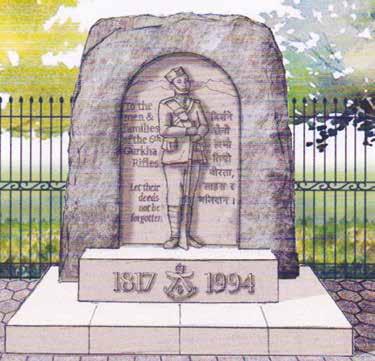
3 minute read
Regimental Memorial Project
from 6 GR Journal 100
6TH QEO GURKHA RIFLES REGIMENTAL MEMORIAL PROJECT
Last year I introduced to you the project for the creation of a Memorial to the Regiment, which had been proposed by John Mackinlay in the Spring of 2018, and approved for further consideration by the Association. That introduction can be found on pages 10 and 11 of the 2019 Journal.
In November 2019, I set out for those who attended the Annual General Meeting of the Association the progress that the Project Committees had made over the year since then. I emphasised that it was in the centre of the fence, bounding the Museum site
important to bear in mind, in appreciating that he consulted widely with experts in the field, drawing
progress, the key points of the Committees’ terms of reference – namely that the Memorial was not to be a “War Memorial”; it should be designed to survive, be aesthetically pleasing and safe from threats of vandalism or earthquake; and ideally located in a safe, accessible location in Nepal.
The Committees’ attention this year has turned to address two aspects of the project: where to locate the Memorial, and what kind of Memorial? The Committees considered and evaluated a number of locations, but ran against the problems of security or maintenance, and also the not insignificant cost of purchasing the necessary land, in the large majority we established a very good relationship with the Gurkha Museum in Pokhara, and I cannot overstate the Committees’ gratitude to the Major Yam and his team at the Museum for their constructive and helpful cooperation with the Committees both here and in Nepal. As a consequence we have agreed with the Museum that our Memorial could be sited in Pokhara, to the left of the Museum entrance. To the extent that anything can be permanent or secure these days, the Committee feels that this site is the best we could ever have hoped for.
Contemporaneously with evaluating possible locations, the Concept Officer (John Mackinlay) progressed the possible design of the Memorial; his first task was to identify a possible sculptor who might have the expertise as well as the required sympathetic approach to the concept of the Memorial; of the potential sites. In the course of our researches
on his contacts in the Memorial Artists Association, and was introduced to Mr Martin Cook, a nationally and internationally recognised sculptor of some of the most important Memorials both in the UK and abroad. The Committee agreed that Martin be given the brief to design a Memorial along lines conceived by John and agreed by the Committee.
The proposed location of the memorial outside the entrance to the Gurkha Museum in Pokhara
We believe the resultant design, shown below, satisfies all the criteria set out in the terms of reference to which I referred earlier; we were encouraged by the positive reaction to the proposed design of those who were at the AGM in November, albeit that a few eyebrows were seen to rise at the estimated cost!
The choice of sculptor has implications for the cost, but the Committee’s conclusion is that, whilst the estimated cost is at the upper end of the likely cost for a sculpture by other artists, the estimate is not significantly in excess of what might be expected – indeed, when viewed against other statue projects currently planned by others, using less well known sculptors at twice the price, the estimate reflects good value for a quality product. The differences in cost are attributable to the levels of artistic as well as technical sculpting skills that are deployed in creating the ultimate product. It is not surprising, therefore, that the initial estimate of the cost for creating a Memorial as depicted amounts to £75,000; that sum excludes VAT and the cost of shipment to Nepal; we are advised by HMRC that VAT is unlikely to be payable, as the Memorial will be exported. The cost of shipment is currently being examined by the Committee. In view of the cost estimate, the Committees are now exploring means whereby there may be cost savings (including the potential for, at least, partial sculpting in Nepal), and addressing the whole question of the viability of the fundraising task.
In conclusion, the Project Committees are satisfied that the Memorial is desirable, and the project is physically feasible. There is an acceptable design and an ideal location. It now remains to address the not insignificant issue of raising the money to pay for it – the financial feasibility of the project is now under the microscope.
Mike Channing











